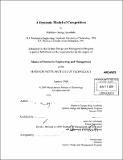| dc.contributor.advisor | James M. Utterback. | en_US |
| dc.contributor.author | Escobido, Matthew George (Matthew George Orias) | en_US |
| dc.contributor.other | System Design and Management Program. | en_US |
| dc.date.accessioned | 2009-10-01T15:53:38Z | |
| dc.date.available | 2009-10-01T15:53:38Z | |
| dc.date.copyright | 2009 | en_US |
| dc.date.issued | 2009 | en_US |
| dc.identifier.uri | http://hdl.handle.net/1721.1/47858 | |
| dc.description | Thesis (S.M.)--Massachusetts Institute of Technology, System Design and Management Program, 2009. | en_US |
| dc.description | Includes bibliographical references (leaves 75-78). | en_US |
| dc.description.abstract | The Lotka-Volterra competition model has been extensively used in the study of technology interaction. It looks at the growth rate of a certain parameter of the interacting technologies through coupled nonlinear differential equations. The interaction is then modeled as a competition with a constant competition coefficient that adversely affects the growth rate. Various studies, however, have suggested that the interaction is not only pure competition and that other interactions are possible. These suggestions have remained mostly conceptual and descriptive - lacking a definite mathematical form of the interaction that can accommodate the suggested variations and the specific implication of those variations. This thesis presents a specific form of the competition coefficient that depends on the cost and benefit of the competition to a particular technology. The cost and benefit functions are patterned after density-dependent (size) interactions in ecology. The resulting competition coefficient is not a constant but varies as the density of the competing technologies changes. Based on the variable coefficient, we extracted steady states and derived conditions of stability to analyze the dynamics of the competition. Results show that the model can provide a richer set of possibilities compared to the constant coefficient. It accommodates different modes of interactions such as symbiosis and predator-prey aside from pure competition in the steady state coexistence between technologies. It allows for shifts from one mode to another during the evolution of the technologies. Lastly, it provides modifications to strategies meant to achieve "winner-take-all" scenario coveted in business. | en_US |
| dc.description.statementofresponsibility | by Matthew George Escobido. | en_US |
| dc.format.extent | 78 leaves | en_US |
| dc.language.iso | eng | en_US |
| dc.publisher | Massachusetts Institute of Technology | en_US |
| dc.rights | M.I.T. theses are protected by
copyright. They may be viewed from this source for any purpose, but
reproduction or distribution in any format is prohibited without written
permission. See provided URL for inquiries about permission. | en_US |
| dc.rights.uri | http://dspace.mit.edu/handle/1721.1/7582 | en_US |
| dc.subject | System Design and Management Program. | en_US |
| dc.title | A dynamic model of competition | en_US |
| dc.type | Thesis | en_US |
| dc.description.degree | S.M. | en_US |
| dc.contributor.department | System Design and Management Program. | en_US |
| dc.identifier.oclc | 432311864 | en_US |
